Cadaques and Port Lligat
 Cadaques is one of the most famous coastal villages in Catalonia and was where the surrealist painter Salvador Dali lived and worked in his coast-side house at Port Lligat. The town is on the Cap de Creus penisular and is really quite isolated separated by 12km of winding narrow roads over the hills from the neighbouring towns of Roses or to Port de la Selva. The remoteness, the narrow streets - some less than a metre and a half wide - and white washed buildings and arid hills behind makes Cadaques feel unique. In some ways it is almost more like a Greek Mediterranean village than Spain. It's this remoteness and uniqueness combined with the pure light of the coast that lures people to Cadaques
Cadaques is one of the most famous coastal villages in Catalonia and was where the surrealist painter Salvador Dali lived and worked in his coast-side house at Port Lligat. The town is on the Cap de Creus penisular and is really quite isolated separated by 12km of winding narrow roads over the hills from the neighbouring towns of Roses or to Port de la Selva. The remoteness, the narrow streets - some less than a metre and a half wide - and white washed buildings and arid hills behind makes Cadaques feel unique. In some ways it is almost more like a Greek Mediterranean village than Spain. It's this remoteness and uniqueness combined with the pure light of the coast that lures people to Cadaques
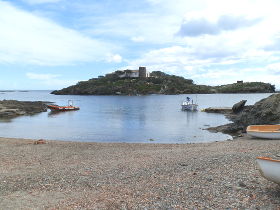 For us this is only our second visit so we're not aiming for a complex route - something simple and straightforward to get a feel for the area is perfectly fine for us, so this is just a standard easy-to-follow Cami de Ronda route.
For us this is only our second visit so we're not aiming for a complex route - something simple and straightforward to get a feel for the area is perfectly fine for us, so this is just a standard easy-to-follow Cami de Ronda route.
Arriving in Cadaques by car there are big signs about the general lack of car parking with the advice that cars should park in the main paying municipal car park which we did, but it's a little expensive - close to 3 euros an hour. If you are walking, we discovered there is free parking out towards Port Lligat and the cemetery which is far enough out of town to be a good 10 minute walk to the centre and would have space out of season.
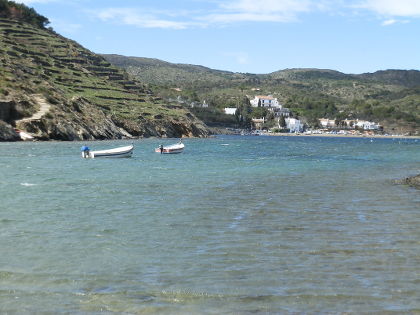 The old part of Cadaques sits on a small hill with the church at the top. The main car park sits just behind this hill, but lower down, so to start we head up the hill towards the church, through the very narrow streets lined with terraces of white-walled houses that give Cadaques its distinctive look. The streets themselves have a stoned surface, though unlike cobblestones these are narrower more slate-like stones with edges upwards in diagonal or herring-bone fashion and in places the road itself is actually the raw rock of the hill.
The old part of Cadaques sits on a small hill with the church at the top. The main car park sits just behind this hill, but lower down, so to start we head up the hill towards the church, through the very narrow streets lined with terraces of white-walled houses that give Cadaques its distinctive look. The streets themselves have a stoned surface, though unlike cobblestones these are narrower more slate-like stones with edges upwards in diagonal or herring-bone fashion and in places the road itself is actually the raw rock of the hill.
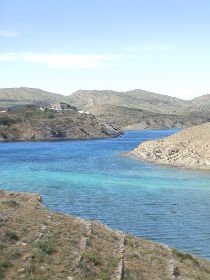 The church, being the high point of this part of the town, has views from its small courtyard in the front towards the sea and along to the cliffs and lighthouse in the distance on the right. Taking our fill, we head down towards the sea through the lanes passing by houses with plant pots outside their windows and pots lining the street edges.
The church, being the high point of this part of the town, has views from its small courtyard in the front towards the sea and along to the cliffs and lighthouse in the distance on the right. Taking our fill, we head down towards the sea through the lanes passing by houses with plant pots outside their windows and pots lining the street edges.
At the beach, the town suddenly seems busier. The beach at Cadaques is a rock and shingle beach - people generally wouldn't come here for a beach holiday - the town has much too much character for that, and the area is generally rocky and stony, with the sedimentary layers of the rocks occasionally turned vertical and eroded and sharp, but perfect for diving, fishing or water sports. The beach itself has plenty of people even for March, though wrapped in coats against the wind. Around the beach area are restaurants and bars and a central statue of Dali looking back towards the town.
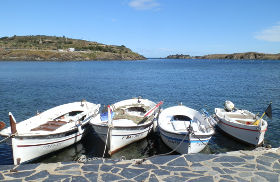 We continue across the beach and then around the Cami de Ronda. To begin with the path shares the road as it runs next door to the sea. We're on the leeside of the bay so the wind has dropped and each time we turn back we get another picture postcard view of Cadaques.
We continue across the beach and then around the Cami de Ronda. To begin with the path shares the road as it runs next door to the sea. We're on the leeside of the bay so the wind has dropped and each time we turn back we get another picture postcard view of Cadaques.
Towards the end of the bay we cross another small rough sand beach and take the path around the outside of a house as it runs around the top of the final set of rocks that have views back to town. Across the bay we can see the cliffs and an isolated lighthouse. There is more walking in this area including routes to Roses about 16km away - too far for a family round trip.
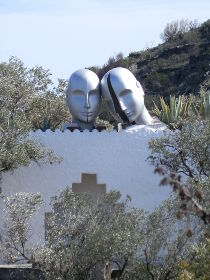 Around the house and the headland, Cadaques disappears and the scenery changes - becoming bleaker with much more rock stringing out into the sea. Across from us is a small island with a house and a watch tower on it. From behind it looked like another headland, but we can see now there is open water between the beach in front of us and the island.
Around the house and the headland, Cadaques disappears and the scenery changes - becoming bleaker with much more rock stringing out into the sea. Across from us is a small island with a house and a watch tower on it. From behind it looked like another headland, but we can see now there is open water between the beach in front of us and the island.
The path continues around any number of rock headlands - perfect for hunting crabs in the summer or for skimming stones from the beaches. The sea in the distance from us is stormy with white horses, but close to the bay the water is smoother. Just inland from the sea front are newer houses and modern architecture villas that seem a little out of place from the wildness of the coast.
At the end of the headland we cross a rise and get the full blast of the wind in our faces. The sea below us is much more open to the elements with waves crashing against the rocks, but with a deep blue sea that we can see all the way to France.
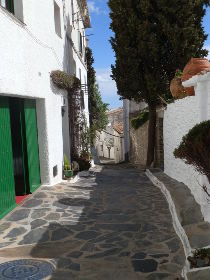 We follow the road down past a row of seaside houses that seem to be snuggling next to each other to keep out the wind. The headland is more like a spit so we have to turn around. Fortunately we see the Cami de Ronda sign which takes us down a narrow track into the woods and a scramble down to the bay between the spit and the main land. In front of us we can see a wild, almost Scottish landscape with the huddle of houses of Port Lligat in the distance, but no other buildings nearby.
We follow the road down past a row of seaside houses that seem to be snuggling next to each other to keep out the wind. The headland is more like a spit so we have to turn around. Fortunately we see the Cami de Ronda sign which takes us down a narrow track into the woods and a scramble down to the bay between the spit and the main land. In front of us we can see a wild, almost Scottish landscape with the huddle of houses of Port Lligat in the distance, but no other buildings nearby.
We cross the beach in the bay and follow the track along the side of this new bay. Above us are ancient looking terracing for olive or vine cultivation that look as if they could have been on the hill since Roman times. The path is still narrow and 2-3 metres above the sea. At one point we have to cross sloping rocks that seem to want us to make us slide into the sea.
And then we arrive in Port Lligat, a handful of brightly coloured fishing boats on the small quayside and then around the corner at we're at Dali's house. We're not visiting the museum and from the port side it looks like a large traditional Catalan house, but with white walls with a few neighbouring houses. We take the chance to enjoy the view and the location then take the road up the hill. As we go up we can see the Daliesque touches like ceramic eggs on the roof and two silver heads, but it is much more subtle touches than Figueres for instance.
Then back into town, cutting into the confusing network of small lanes to see if we can navigate our way back. We arrive at the main square with trees wearing knitted sleeves and navigate through more streets and back to the car.
Neighbouring walks: Cadaques to Roses - Roses and Roses Ciutadella - Roses - Canyelles beaches to Cap Falconera - Port de la Selva - Sant Pere de Rodes - Llança - Collioure (France)
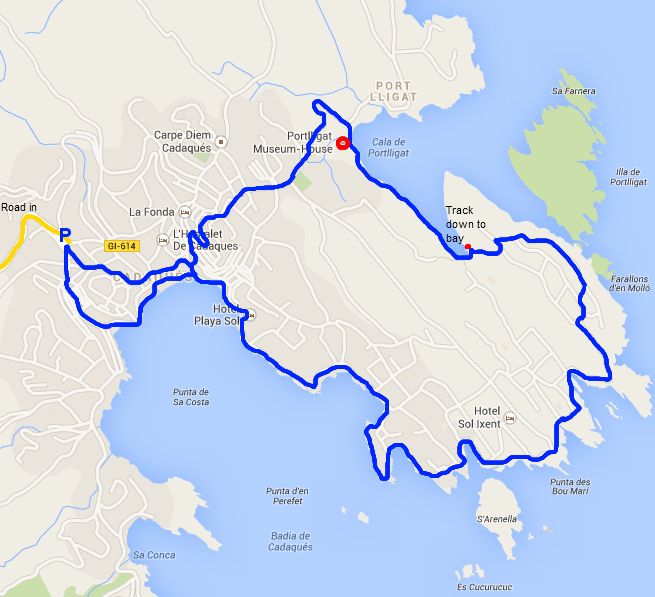

 Walks and other things
Walks and other things